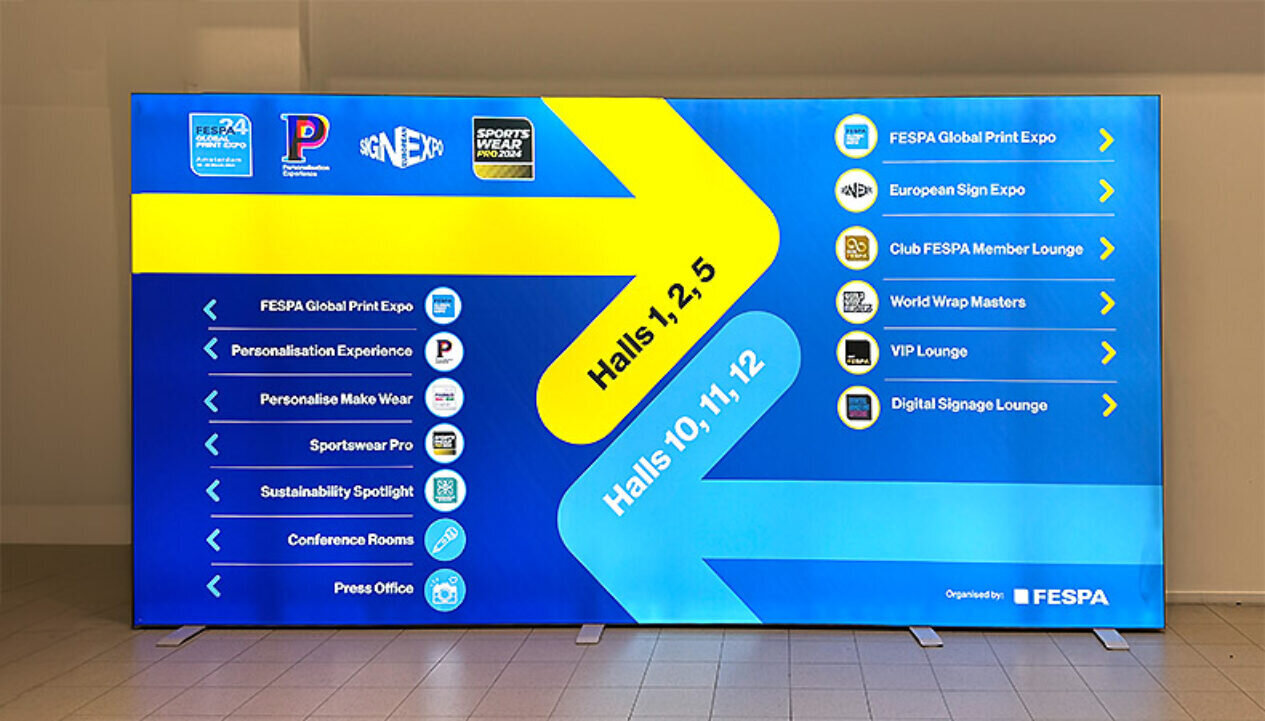
Sonja Angerer discusses the pros and cons of both digital signage and printed signage. Current developments such as artificial intelligence and spatial computing are changing the situation once again. How will this shift affect printers?
Printed signs have been a vital part of the advertising landscape for centuries. Meanwhile, digital signage has seen an unprecedented rise in recent decades. This was also clearly visible at the European Sign Expo 2024 in Amsterdam. For the first time, the trade show alongside the FESPA Global Print Expo (19 – 22 March 2024) offered a Digital Signage Lounge with an exhibition area that focused entirely on advertising on screens.
The benefits of Digital Signage
The benefits of digital signage are quite evident, it provides dynamic content that can be updated in real-time. So, advertisers can change the way they address the audience, as well as display special offers or prices at any time. This allows them to quickly react to unexpected events, such as a sudden downpour of rain. How about a little coffee break until the shower has subsided? Or just buying a new umbrella?
Digital signage is often connected to the internet. This makes it possible to access databases that may record the local weather or the sales of certain goods. For a long time now, there have also been modules, e.g. from Nexmosphere, a software that can detect the age and gender of the person standing in front of the screen. It is quite possible that artificial intelligence (AI) will be used more commonly for this in the future.
In day-to-day operations, digital signage also generates far less waste than printed signage. After the end of a campaign, there is no need for square meters upon square meters of paper, foil, or textile to be dismantled and recycled. A few clicks are all it takes to launch new campaigns. Digital signage also reduces the strain on employees in sales and visual merchandise, as they often need to assemble printed signage overnight so that customers see advertisements for the latest products when the store opens.
Technological advances have made connected digital signage applications more accessible and user-friendly. Previous generations of public displays required specialised technical knowledge, while modern systems are easier to install and maintain.
Digital signage has become indispensable at trade show booths.
Image credit: S. Angerer

The benefits of Printed Signage
Printed signage is still widely used at the point of sale, for indoors and outdoor advertising. That is due to their many advantages. Print advertising is very cost-effective. Compared to other advertising channels such as television or radio advertising, creation and production is cheap and fast.
If there are frames already installed on site, mounting of posters, mega posters and light box coverings can be very efficient because no specialist staff, internet access or power connection is required. That is why signs for emergency exits are often printed in fluorescent paint, as they will also be clearly visible regardless of a power outage.
Printed advertising is very durable and cost-effective, which also makes it suitable for locations where more vandalism is expected, like neighbourhoods that are largely populated with tourists, clubs, or bars. If a poster is defaced or destroyed, it takes much easier to replace it than to put up a new digital display.
Printed advertising can be easily dismantled and disposed of. In Europe, advertising materials on cardboard and paper are predominantly recycled with wastepaper. But there are also many ways to recover textile and foil-printed advertising materials too.
Printed advertising is familiar and reassuring. So, this may mean that many would prioritise it over Digital Signage. People with special needs, such as the visually impaired or passers-by with attention deficit disorders, also generally cope better with static content. On printed posters it is still easy to create the opportunity for interaction and printed QR codes offer easy access to websites.
Printed large-format signage requires less power than a screen of the same size.
Image credit: S. Angerer

Disadvantages of Digital Signage
One of the main disadvantages of Digital Signage is the high initial investment required for installation and maintenance, even though Mordor Intelligence estimates the European digital signage market will grow by almost 11% annually until 2029.
However, suitable screens with 40 inches or more may still cost roughly 700 euros each from the European market leaders Samsung and LG. In addition, there is housing, mounting and, of course, software. The massive increase in electricity and labor costs in the last 2 years has also made ongoing maintenance considerably more expensive.
Furthermore, more customers are asking questions about the environmental impact of Digital Signage. Electricity and resource consumption, waste heat and light pollution contribute to a significant ecological footprint. Manufacturers have only just begun to tackle the problem. In addition, the disposal of e-waste is often still carried out under unsafe and unfair conditions in the Global South.
Dependence on technical infrastructure also entails certain risks, as system failures or software problems can lead to vital information to not be displayed in a timely manner. Privacy is also a critical issue, especially when Digital Signage also uses tracking or age / gender evaluation. Many people feel that their privacy is violated by such practices.
Constantly updating content can also require a significant amount of time, as screens are expected to be kept up-to-date and relevant. Therefore, maintaining content management systems for digital signage in companies uses a considerable amount of resources. These may be missing elsewhere and distract from other important tasks.
At the European Sign Expo 2024, there was an area dedicated to Digital Signage.
Image Credit: FESPA

Disadvantages of Printed Signage
Printed advertising, such as brochures, posters or displays, once were the foundations of the advertising industry. Most advertising campaigns were designed with a clear focus on print products, even if other advertising channels such as TV or radio spots were added. This has changed a lot within the last few years and will continue to do so. According to Statista, sales of printed advertising in Germany are expected to fall by almost 3.7% annually until 2028.
The biggest disadvantage of printed advertising is the lack of flexibility. This is because once printed, the advertisement cannot be updated or changed. Of course, it is easy to create personalised mailings to be printed digitally. However, many other forms of printed advertising do not allow for quick and flexible adaptation to target groups or current events.
In addition, statistics of print communication is much more difficult to obtain than digital and online advertising. As a result, advertisers are often not sure whether they are reaching their target group at all.They are concerned that younger shoppers, may hardly notice printed advertising at all.
Costs for printing and distribution of signage are often higher at first compared to digital alternatives. This is especially true for large-format and outdoor advertising. The environmental impact of printed signage is also considerable, as paper consumption and waste production increase the environmental footprint of companies.
Advertising materials printed on paper and cardboard are easy to recycle. This is more complicated with giant posters on mesh or tarpaulin, vehicle foils or soft signage. Even though the industry has now made great strides on the way to “green printing“.
Conclusion: Will print advertising disappear?
The question of whether digital signage or printed advertising and signage is more beneficial for your business is dependent on on several factors. These include, target groups, location, purpose of signage and budget. In the future, artificial intelligence will help marketing managers analyse large amounts of data and support their decisions.
In a very lively and technological environment, such as shopping centres or airports, Digital Signage has a clear advantage. However, in rural or historical contexts, printed signage may be preferable. It does not consume any energy after installation. Therefore, printed material is better suited for long-term advertising because it saves energy and raw materials.
However, future developments could lead to a loss of importance for both digital and printed signage. Augmented reality (AR) and virtual reality (VR) video glasses have been around for years. But Apple unveiled its first spatial computer, Vision Pro, in June 2023. It is quite possible that this will lay the foundation for a broad acceptance of spatial computing.
Maybe in a few years we will all be walking around with digital glasses on our noses most of the time? Then passers-by will see advertising and communication on their own screen based on their location. Maybe there will even be ad blockers that hide any outside advertising.
Overall, it can be said that both digital signage and printed signage currently have their purposes. At least for the immediate future, they are likely to coexist. The better technology will therefore not be clear but will depend on the needs and preferences of users and providers. For the advertising industry as well as for printers, it will is important to combine the best of both worlds and make the most of the advantages of both forms of signage.
At European Sign Expo, FESPA spoke to Xavier Xavier Carreras Sanchez, Strategic Account Manager at Navori Labs about how to offer clients a combination of both digital and traditional signage to generate the most effective content. Watch his interview here.